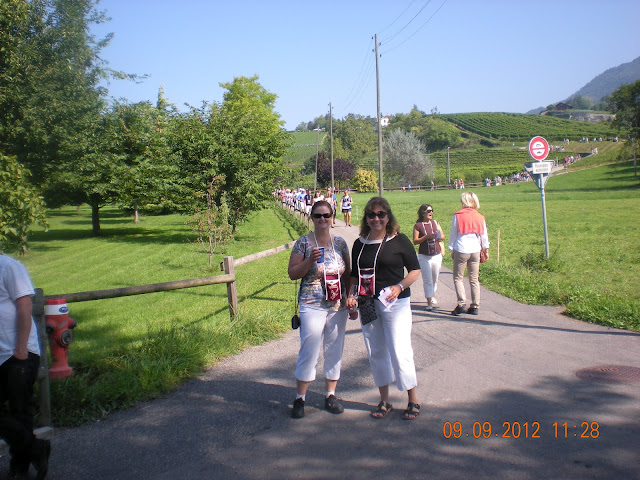A little Swiss wine history:
The tradition of vineyards and wine in Switzerland is very old, at a minimum from
the Roman era. Some archaeological evidence seems to prove
that grapes were planted in Valais (the southern region of Switzerland) earlier than the Roman era. In an
archaeological excavation near Gamsen, (also in the southern region of Switzerland), some old grape seeds were found that dated back to the Iron age.
Swiss wine is produced from
nearly 37,000 acres of vineyards and the wines are mainly produced in the west, southern and northeast regions of Switzerland. White grapes varieties are grown on 42% of the country's vineyard surface, and
red grape varieties on 58%.
According to data from the Swiss Federal Office
of Agriculture the Swiss wine
production in 2010 was just over 29.5 million gallons, divided into 14 million gallons of white wine and 15.5 m gallons of red wine. Nearly all the national production
is drunk within the national boundaries; less than 2% of the wine is exported
(mainly to Germany).
Switzerland produces 160 grape
varieties, an extraordinary number given the size of the national vineyard.
The explanation lies in the geography
of the country, which varies hugely, from the open lakeside near Geneva to the
remarkably steep banks of Lavaux at the eastern end of the lake (near Vevey), to the plains
around Vully (the western region near the French border) and the Alpine slopes of Valais (the southern region near the Italian border) and Ticino (the southeastern region, also near the Italian border), not to mention the
stretches along Lake Zurich and in the foothills of Graubuende (the northeast region of Switzerland). See the map below.
The most commonly grown white grape varieties are; Chasselas (which accounts for 27% of all wine production), Mueller-Thurgau, Chardonnay, Sylvaner, Pinot Gris, Petite Arnive, Sauvignon Blanc, Pinot Blanc and Savagnin Blanc. Chasselas wines, which are full, dry and fruity, are commonly paired with raclette and fondue, two of Switzerland's most popular dishes. It is also suitable as a table grape, grown widely for this
purpose in Turkey.
The most commonly grown red grape varieties are; Pinot Noir (which accounts for 30% of all wine production), Gamay, Merlot, Gamaret, Garanoir, Syrah, Humagne Rouge, Cornalin and Diolinoir.
The areas in brown are the major wine producing regions of Switzerland.
We have arrived in the town of Chailly, for the start of "Route Gourmande".
The route is marked by a dotted line, just left of the town of Chailly.
Paula with Mike and Courtney, two of our friends from Nestle. Notice the pouches around their necks to hold their wine glass. There were about 30 people in our group. However, there were hundreds of people who participated in the event. Groups, of varying size, would begin the walk, about every 20 minutes, from mid-morning until early afternoon. It took us about 5 hours to complete the route.
Beginning the walk.
One of the many vineyards that we walked through.
Chasselas grapes. The grape harvest usually begins around the middle to late September. However, this year because the weather has been cool and wet, the harvest will be delayed until at least the 2nd week of October. According to some wine makers, 2012 will not be a good wine year, due to the extended bad weather.
The first of many wine tasting stations.
A view of one of the many vineyards in the region.
The green netting covering the grape vines is the protect the grapes from being eaten by the birds. We also notices that the growers use a white netting that they just wrap around the lower half of the vines to protect them from the birds. It would seem that it would be less costly and less labor intensive to use the white netting.
The gentleman in the striped shirt, Mark, who's wife also works for Nestle, co-ordinated getting our group of 30 people together.
In addition to growing grapes, this vineyard also had a huge pear orchard. The trees are just loaded with pears, almost ripe for the picking.
From left to right - Barbara (Mike's wife), Peter, Mike and Paula, tasting one of the red wines.
The first, of the six courses, was a smoked trout and whitefish in a wild garlic and herb sauce. We had expected tiny food tastings, but instead got servings that were very generous and absolutely delicious.
In addition to all of the wine tasting stations, at each of the food stations, the chefs paired the appropriate wines to go with their dish.
On our way to this chateau were the soup course was served.
The chef is stirring the pea soup. As you can see, it was prepared in a large copper kettle.
Paula and Courtney enjoying the pea soup.
The chateau had this beautiful flower garden.
This Jazz band performed during the soup course.
On our way to the next wine tasting station.
When we arrived at the next station, these gentlemen were playing Alpen Horns.
Another wine tasting station.
The third course was hot ham with potatoes in an autumn dressing.
Look at that serving size!!
At the next wine tasting station, Paula is listening to the gentleman explain his wine offerings.
Paula met Renata during the walk.
A view of one of the many vineyards in the region.
On our way to the next food station.
The fourth course was a selection of Swiss cheeses.
The fifth course was sliced apricots on puff pastry with powered sugar.
On our way to the last food station.
The sixth and final course was dessert. The chef is piping semi-sweet cream on the plates of meringue.
The dessert consisted of two pieces of meringue with semi-sweet cream.





































How did you all get to the start of the route?
ReplyDeleteWow what a great blog, i really enjoyed reading this, good luck in your work. Zurich to vevey
ReplyDelete